Legit or deceptive? Call to hire 30,000 teachers per year not new
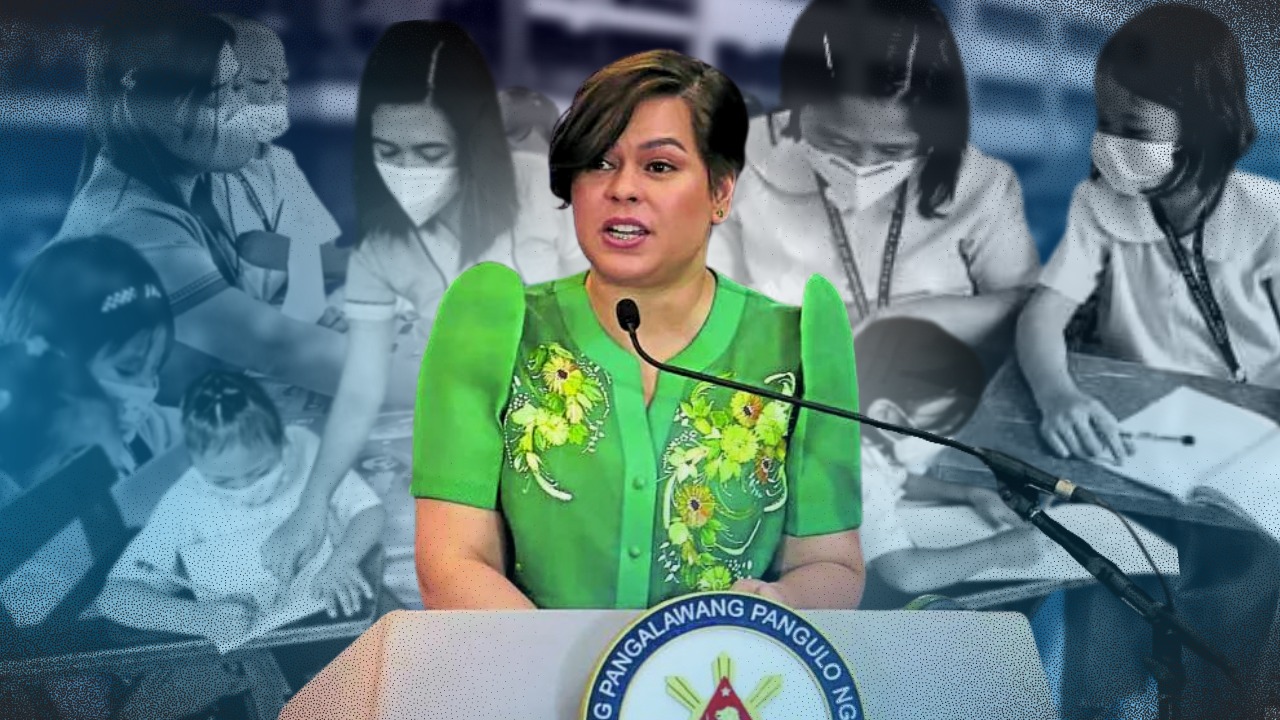
COMPOSITE IMAGE: JEROME CRISTOBAL FROM PDI/INQ STOCK PHOTOS
MANILA, Philippines—As early as 2013, a bill had been filed to set the “standard class size” to 35, but this year, as the Alliance of Concerned Teachers (ACT) said 30,000 new teachers should be hired yearly to reach that ideal class size, Vice President Sara Duterte said it was “unrealistic” and “impossible.”
Last March 31, Duterte, who is also education secretary, said the Department of Education intends to hire more teachers every year, as part of its Basic Education Learning Recovery Plan. “We agreed that we will be hiring every year,” she said.
So ACT, stressing the need to improve the quality of education in the Philippines, said the DepEd should hire 30,000 new teachers yearly until 2028 to address the shortage of teachers in public schools.
READ: 30,000 teachers must be hired yearly until 2028 to get ideal class size – ACT
But Duterte said ACT’s proposal is “obviously deceptive maneuvers” to undermine the government’s solution to education problems: “The call could not be coming from a place of genuine concern for the future of our learners and the welfare of our teachers.”
“It is a call motivated by the group’s fascination for demands and goals that are unrealistic and impossible — placing the government in a precarious situation that will ultimately end in failure,” she said.
But is this really the case?
ACT’s proposal
Yes, the 30,000 that ACT said should be hired every year may seem massive, but the call, including the demand to construct 50,000 classrooms, is “perfectly legitimate and logical,” the alliance said.
RELATED STORY: Teachers’ group to gov’t: Build more classrooms, address nationwide shortage
ACT chairperson Vladimir Quetua stressed that the Philippines currently lacks 147,000 teachers to “decisively reduce the class size to 35 students and ensure that our teachers can effectively teach and monitor the progress of each of our learners.”
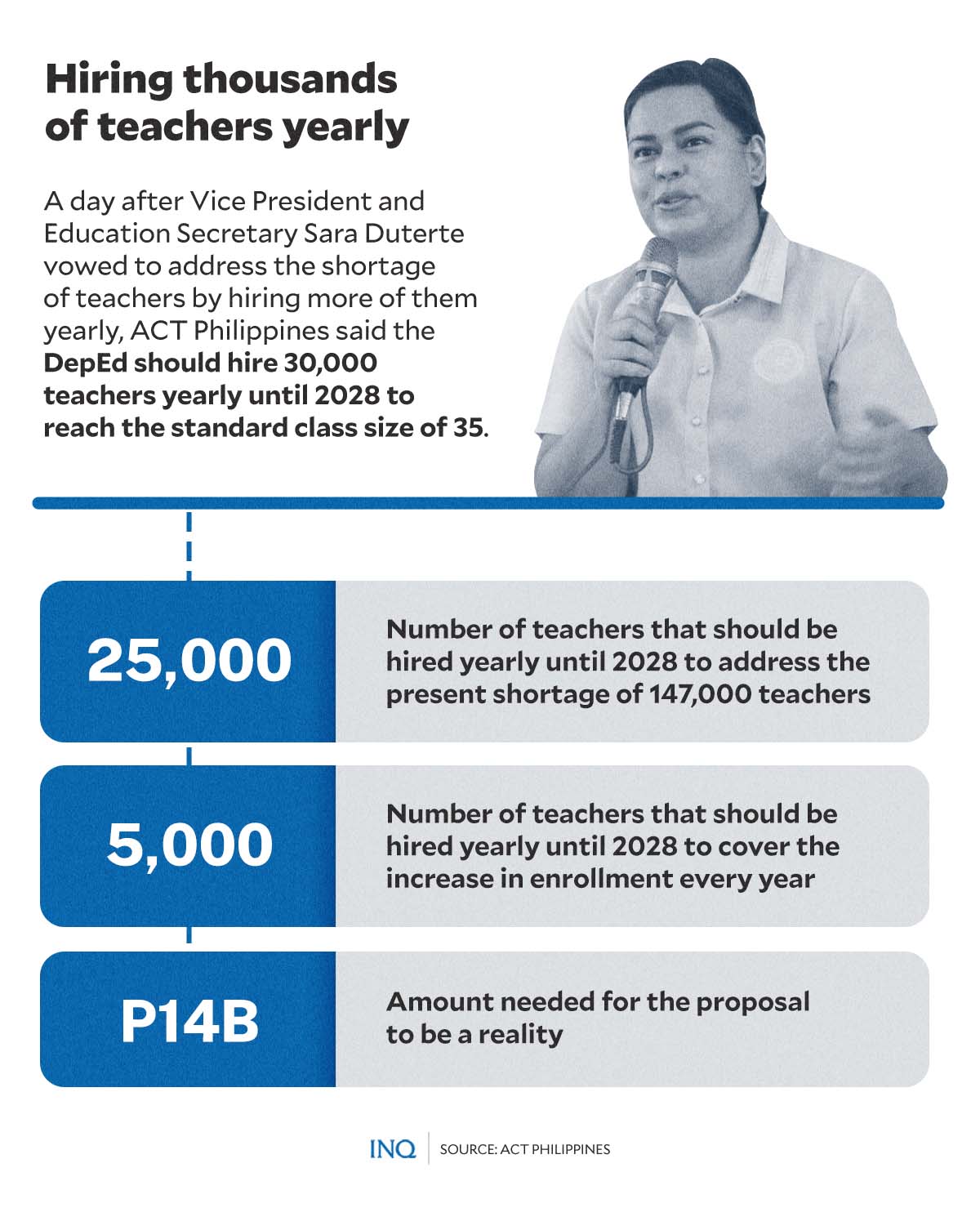
GRAPHIC Ed Lustan
Quetua did the math. He explained that to fill the shortage of 147,000 teachers, “we need to hire 25,000 new teachers until 2028” and 5,000 new teachers to “cover the yearly increase in enrolment,” making the requirement 30,000.
RELATED STORY: PH needs 147,000 new teachers, hiring 10,000 not enough — ACT
Quetta said “there is nothing new with the program of hiring new teachers every year as national budgets in the past already provided for the creation of 5,000 new teaching items every year.”
The problem, however, is that these were only enough new teachers to cover the increase in the population of learners, and not to cut down the class size to improve the quality of education in the Philippines, he said.
But contradicting ACT, Duterte said “instead of solely focusing on archaic and ineffective solutions, we will also tap into available technology to address current challenges,” stressing that the government “will not be pressured, hoodwinked, or distracted.”
READ: VP Duterte: Hiring 30,000 teachers yearly ‘unrealistic, impossible’
“These form part of the reforms that we will implement to ensure the effective delivery of basic education to Filipino learners and champion teachers’ welfare,” Duterte said.
Ideal class size
But as ACT pointed out, “even more disgusting is her desperate bid to discredit our calls by maliciously connecting our good intentions to the armed conflicts in Masbate province,” saying that the group’s demand “has been as old as the education shortages in the country.”
It said “it has always been the depressing state of education quality and the daily sufferings of hundreds of thousands of our public school teacher-members that prompt ACT to propose meaningful educational reforms.”
Based on what the DepEd said in 2018, the class size was more ideal that year than in 2017, with a teacher-student ratio of 1:31 for elementary and senior high school, and 1:36 for junior high school.
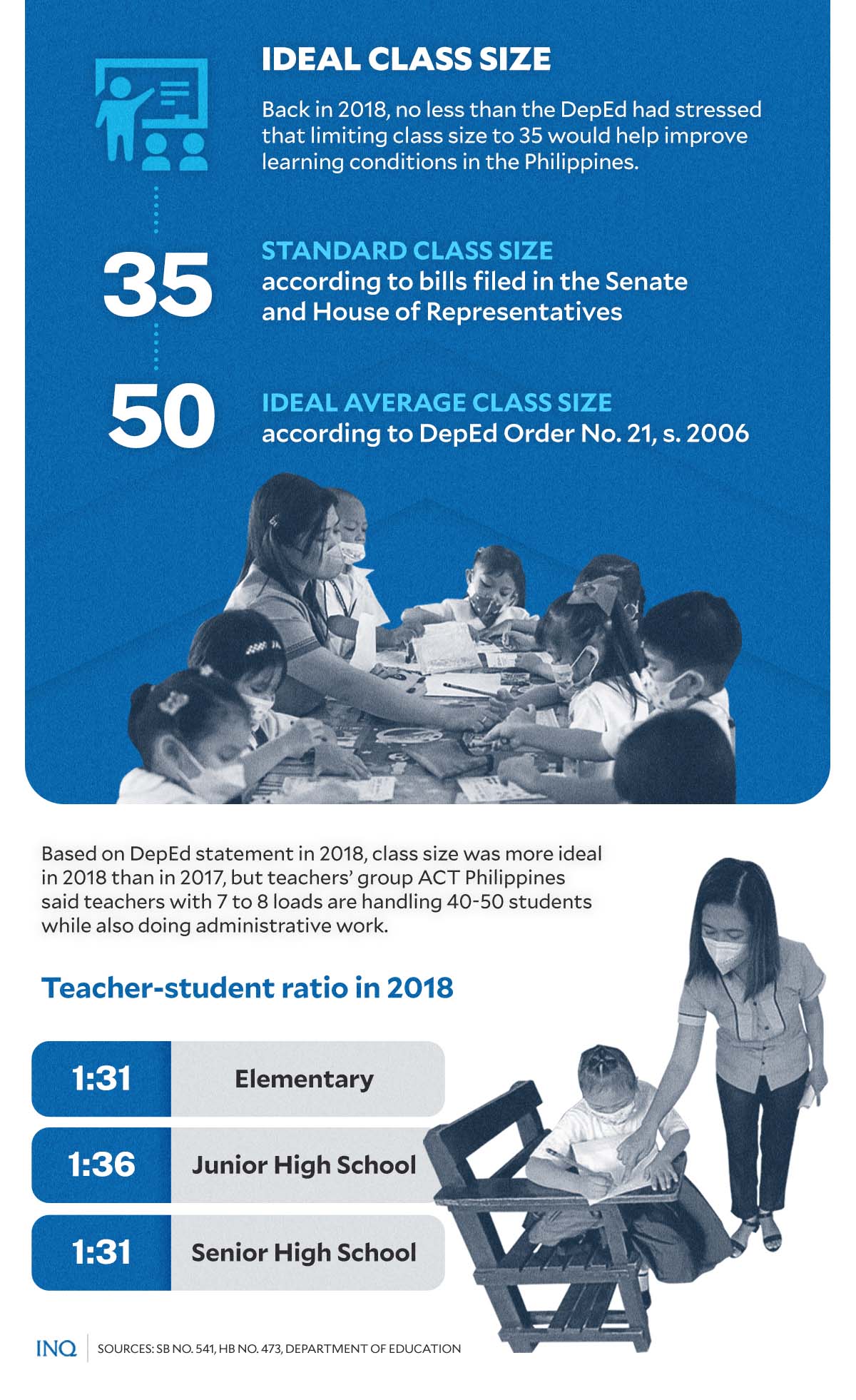
GRAPHIC Ed Lustan
However, it was stressed by ACT that teachers with 7 to 8 teaching loads are currently handling 40 to 50 students per class while also attending to administrative responsibilities in their schools.
READ: For PH teachers groaning under weight of low pay, Thailand beckons
As early as 2013, Antonio Tinio, who was representative of ACT Teachers from 2010 to 2019, and the late Sen. Miriam Defensor-Santiago filed bills to propose the enactment of a law that will set the class size in all public elementary and secondary schools in the Philippines.
It was stated in Senate Bill No. 1892 that “in all public schools in the country, each class to be handled by a single teacher shall have a standard size of 35 or less students” and that “any class with not more than 35 students shall be considered a standard class.”
“Any class with more than 35 students up to a maximum of 50 students shall be considered a large class. In no case shall a class size in excess of 50 students be permitted,” the bill, which was filed on Oct. 24, 2013, read.
RELATED STORY: Since the ’80s, teachers still overworked, underpaid
It provided that a teacher handling a large class shall be entitled to a large class honorarium equivalent to one percent of his or her daily rate for every student in excess of the standard class size of 35.
String of bills in Congress
The average class size in the Philippines, as stated in DepEd Order No. 21, s. 2006, is 50, but as stressed in the bill filed by Defensor-Santiago, “classrooms in the Philippines are the most crowded in Asia.”
This was the reason that her bill was not the last one that the Congress has seen as Tinio also filed House Bill (HB) No. 473 in 2016, while Sen. Grace Poe filed SB. Nos. 1190 and 541 in 2019 and 2022.
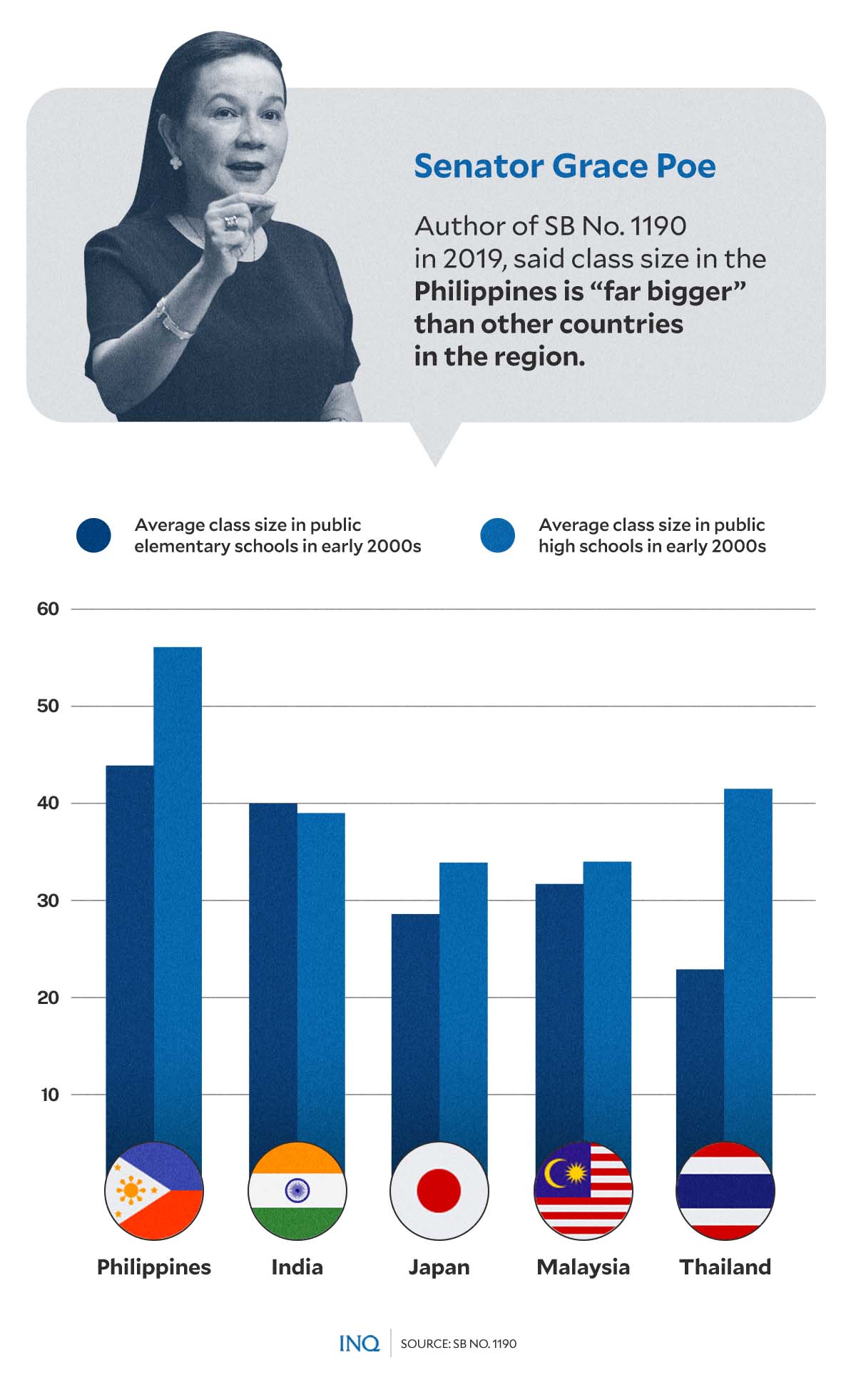
GRAPHIC Ed Lustan
Based on Poe’s bill, in the early 2000s, the average class size of public elementary schools in the Philippines was 43.9, “far bigger” than Thailand’s 22.9, Malaysia’s 31.7, Japan’s 28.6, and India’s 40.
Then in public high schools in the Philippines, the average class size, Poe stated in the bill’s explanatory note, was 56.1, way higher than Japan’s 33.9, Malaysia’s 34, India’s 39, and Thailand’s 41.5.
“It is not enough to just bring in students to school. We must ensure that learning actually happens once they are in school. Class size is one factor to consider when evaluating a school’s effectiveness,” she said.
Poe stressed that “education researchers have found that class size reduction in the early grade helps students achieve because there is a greater opportunity for individual interaction between student and teacher in a small class.”
Based on the 2014 Position Statement by the National Council of Teachers of English that was reiterated by Poe, “it is a known fact that class size has a considerable impact on students’ learning.”
“Students in smaller classes tend to perform better in all subjects and all assessments when compared to those in larger classes. Students also talk and participate more in smaller classes, and are much more likely to interact with their teachers rather than passively listen,” said Poe in her bill.
Class size matters
As Tinio stressed when he filed HB No. 473, “it is no longer uncommon to see teachers handling classes with 60 to 80 students,” saying that “an oversized class is one of the main causes of the marked decline in the quality of education provided by our public schools.”
Based on results of the Southeast Asia Primary Learning Metrics 2019, only 10 percent of students in the Philippines met the minimum reading standard and 17 percent met the minimum mathematical standard expected at the end of primary education.
Grade 5 students in the Philippines received an average score of 288 in reading assessment, behind Vietnam (336), Malaysia (319), Myanmar (292) and Cambodia (290). The Philippines was ahead only of Laos, where students got an average score of 275.
While the 288 means a Filipino Grade 5 student can read a range of everyday texts fluently and comprehend their meaning, only 10 percent achieved the minimum proficiency level, which is the ability to understand texts with familiar structures and manage competing information.
The average score of Filipino Grade 5 students in mathematics assessment was also 288, indicating that they can generally apply number properties and units of measurement, but only 17 percent had the ability to perform mathematical operations, including fractions, and interpret tables and graphs.
The Philippines and Myanmar, where students also got an average score of 288, were behind Vietnam (341), Malaysia (315) and Cambodia (289), and were ahead of Laos, where Grade 5 students received an average score of 279.
When it comes to writing assessment, Filipino Grade 5 students also received an average score of 288, behind Vietnam (327), Malaysia (318) and Myanmar (298), and ahead of Cambodia and Laos, where students got an average score of 285 and 283.
This suggested that a student in the Philippines can produce very limited writing with fragmented ideas and inadequate vocabulary as some 46 percent fell to the lowest proficiency band in writing.
Back in 2018, Jesus Mateo, who was then the DepEd’s official for planning and field operations, said limiting class size to 35 or fewer students would help in improving the quality of education in the Philippines.
Gov’t capable
As Queta asserted, the government will need about P14 billion to hire 30,000 new teachers every year since based on data from the Department of Budget and Management, personnel services cost of an entry-level teacher is P465,760 a year.
RELATED STORY: VP Duterte’s education report ignored pay hike calls – teachers
“We are sure the people’s taxes can support this if only the government would give due premium to education,” he said. “The DepEd also needs to resolve the bureaucratic red tape that hinders speedy hiring of teachers.”
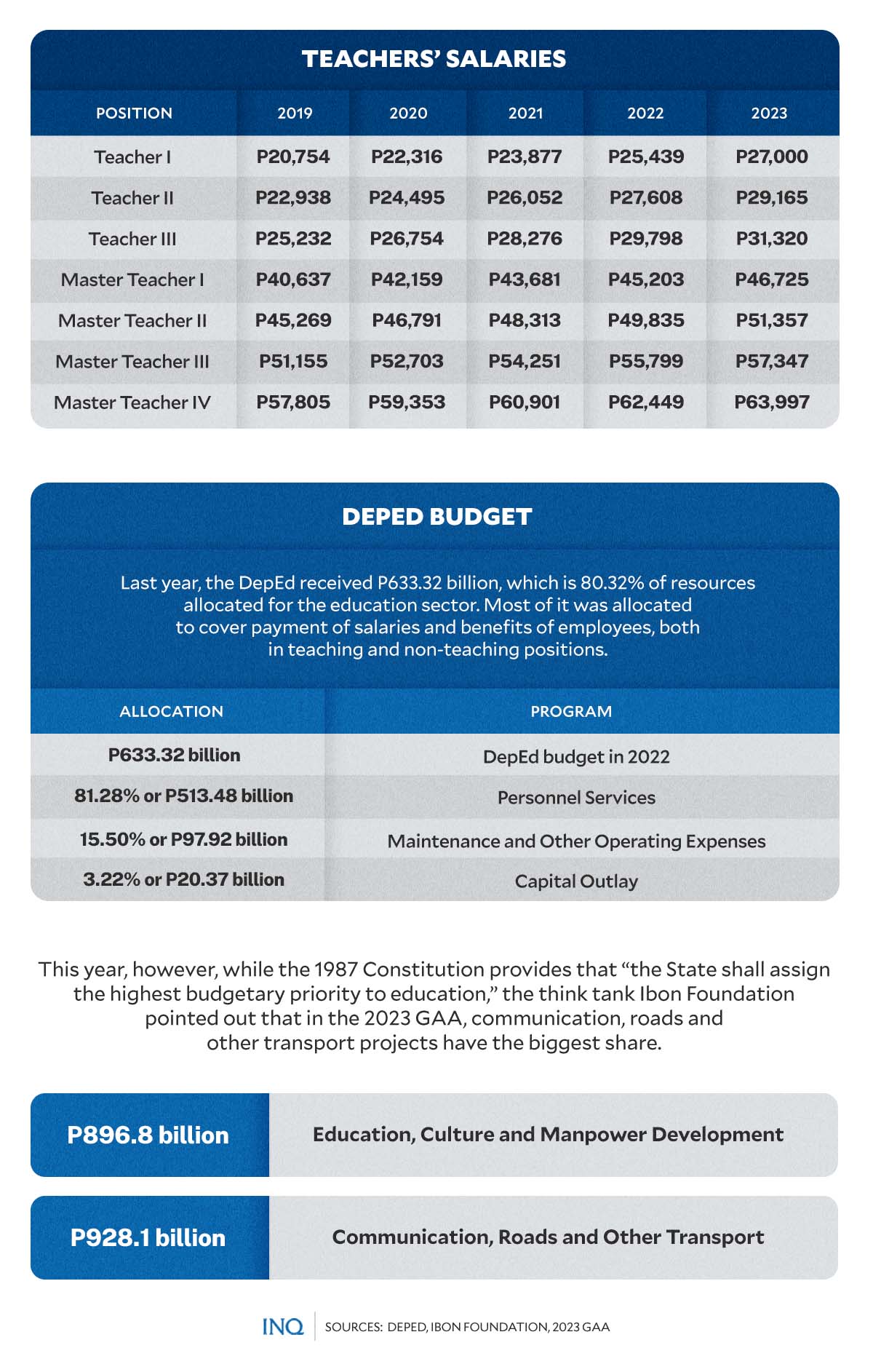
GRAPHIC Ed Lustan
Based on data from the DepEd, the department received P633.32 billion in 2022, which is 80.32 percent of the budget allocated for the education sector. Most of it was allocated to cover the payment of salaries and benefits of employees, both in teaching and non-teaching positions.
The 633.32 billion was divided into Personnel Services (81.28 percent or 513.48 billion), Maintenance and Other Operating Expenses (15.50 percent or 97.92 billion), and Capital Outlay (3.22 percent or 20.37 billion).
Section 5(5) of the 1987 Constitution provides that “the State shall assign the highest budgetary priority to education and ensure that teaching will attract and retain its rightful share of the best available talents through adequate remuneration and other means of job satisfaction and fulfillment.”
However, this year, the think tank Ibon Foundation pointed out that in the 2023 General Appropriations Act, Communication, Roads and Other Transport has a higher share at P928.1 billion, compared to the P896.8 billion allocated for Education, Culture and Manpower Development.
RELATED STORY: Sara Duterte told: Teachers give 200% effort, scarce budget stalls PH education reform














